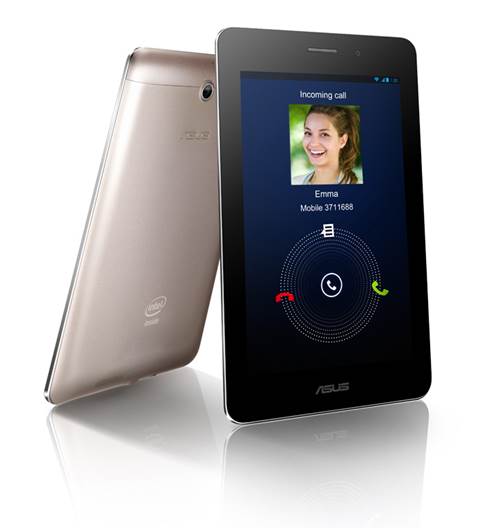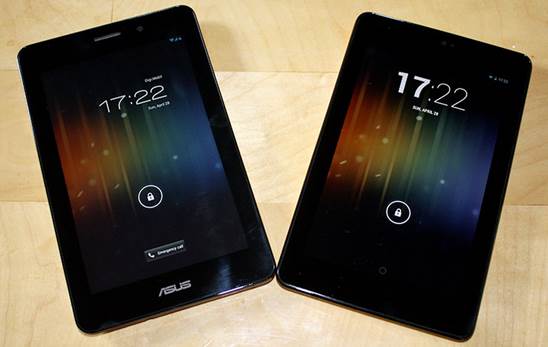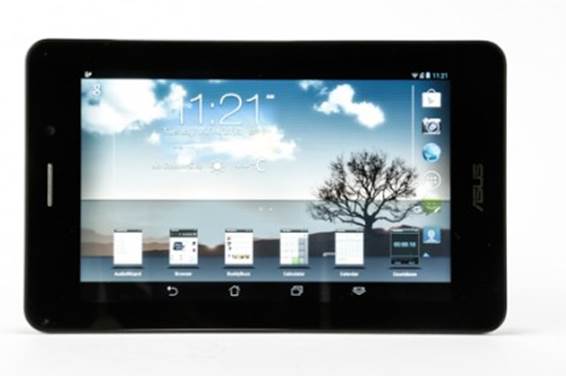A compact tablet boasting 3G
connectivity and phone features for a ludicrously low asking price, combined
with excellent battery life, acceptable performance and a decent screen
The Asus Fonepad is a curious mix of
devices: it’s a 7in tablet with 3G, but it’s also a fully-fledged smartphone,
complete with an integrated earpiece and microphone, so you can go all Dom Joly
making phone calls on the bus home.

The
Asus Fonepad is relatively chunky
In reality, the chief appeal of the
Fonepad, aside from providing a talking point down the pub, is its exceedingly
good value. It will set you back only $288 inc VAT, and when you think about
what you’re getting for the money - a smartphone and a 7in 3G tablet similar to
the Nexus 7 in one package - it’s a remarkable budget buy.
Fonepad vs Nexus 7
The physical similarity between the Fonepad
and the Nexus 7 is striking, and perhaps shouldn’t be all that surprising,
given that the two tablets are made by the same company. The screen surround is
the same width, the screen is the same resolution (800 x 1,280) and size -
giving a pixel density of 216ppi - and it employs the same IPS technology, too.
In the UK, the Fonepad is available with only a front-facing 1.2-megapixel
camera - just like the Nexus 7.

The
physical similarity between the Fonepad and the Nexus 7 is striking
However, there are big differences between
the two tablets elsewhere. Take the rear panel: the Fonepad is made of smooth,
matte plastic, where the Nexus 7 is textured and rubbery, and the Fonepad has a
pop-off panel at the top for access to the tablet’s SIM and microSD card slots.
The Nexus 7 has no way of expanding storage; the Fonepad can accommodate
another 32GB in addition to its internal 16GB (or 32GB).
The other big difference lies inside the
Fonepad: it sports a single-core, Hyper-Threaded 1.2GHz Intel Atom Z2420 CPU
and 1GB of RAM instead of the quad-core, 1.3GHz Nvidia Tegra 3 of the Nexus 7.
Despite the discrepancy in the number of cores, performance is comparable. In
the stock Android browser, we recorded a score of 1,240ms in the SunSpider
test, and it achieved a mid-range 2,935 in Quadrant. The Nexus 7 was actually
slower in the single-threaded SunSpider test (1,683ms), but surpassed the
Fonepad in the more demanding Quadrant, with a score of 3,687.
In general use, the Fonepad is fluid and
responsive. Swiping from homescreen to homescreen, panning and scrolling was a
pleasant experience, and it handled all the demanding games we threw at it,
from Modern Combat 3: Fallen Nation to Real Racing 3.
Stamina and screen
With a huge 4,270mAh battery onboard, it’s
no surprise that battery life is excellent. We ran the same tests we run on all
smartphones, with 3G on and Wi-Fi off, and, after a day of syncing Gmail,
downloading 50MB of data, 30 minutes of phone calls, an hour of screen-on time
and an hour of audio playback, the Fonepad had 80% capacity remaining on the
gauge. That’s right up there with the very best smartphones; in the video
looping test we run on all tablets, with flight mode on, its result of 12hrs
58mins is the best we’ve seen from a tablet of its size.

With
a huge 4,270mAh battery onboard, it’s no surprise that battery life is
excellent.
Even the screen quality is good. At maximum
brightness, we measured it at 316cd/m2 - only a fraction less than the Nexus
7’s 330cd/m2. Color reproduction is a touch less vibrant than the best compact
tablets, but our only major complaint is that the glass on the front picks up
greasy fingerprints too easily, hindering readability outdoors.